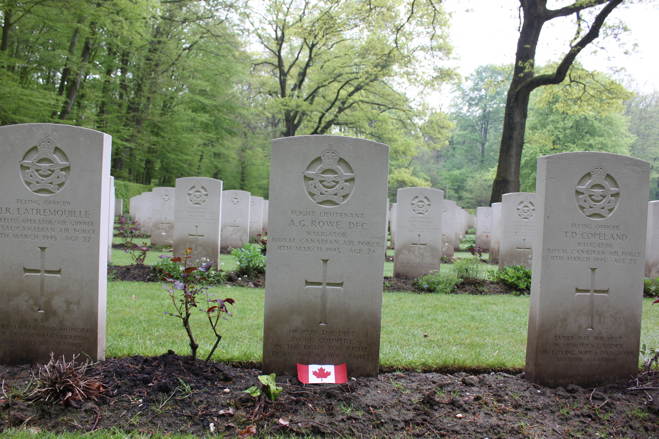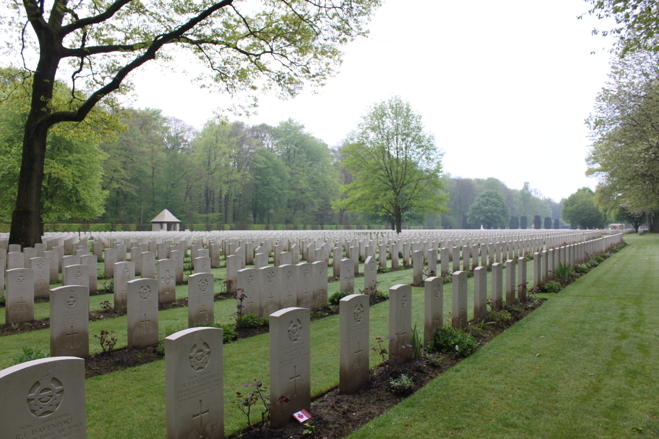 Aircrew Chronicles
Aircrew Chronicles  |
Aircrew Losses
|
Nose Art
|
BCATP
|
Lancaster
|
Media
|
Aircrew Losses
|
Nose Art
|
BCATP
|
Lancaster
|
Media
 Aircrew Chronicles
Aircrew Chronicles  |
Aircrew Losses
|
Nose Art
|
BCATP
|
Lancaster
|
Media
|
Aircrew Losses
|
Nose Art
|
BCATP
|
Lancaster
|
Media
Bomber Command Aircrew Chronicles
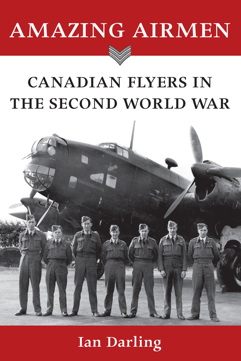
During the second world war on March 11th 1945 the end was near for Nazi Germany as the allies were driving Hitler's forces of evil into forced retreat throughout what once was the Nazi's occupied fortress Europe. Seeking to cut off the vital German supply lines 1,079 allied aircraft, 750 Lancaster's, 293 Halifax's and 36 Mosquito's of all Royal Air Force bomber groups departed for a dangerous daylight operation on the industrial city of Essen Germany. This mission is recorded historically as the second largest bombing attack of the second world war surpassed only by the 1,108 RAF daylight plane attack on Dortmund on the following day March 12th. It was also one of the few daylight bombing missions the RAF was to have participated in. The enormous numbers of allied aircraft that were involved in this operation was reported by Air Force veterans who took part to be some eight miles long and some five miles wide. 4,661 tons of bombs were dropped on H2S navigational radar directed sky markers through complete cloud cover. The attack was accurate leaving Essen virtually in ruins until the American 9th Army took control over the city on April 10th 1945. This was the last RAF bombing mission on Essen which had been attacked many times in the early years of the war with such disappointing and costly results.
|
Three RAF Lancaster's were lost on this mission to Essen. Wing Commander Ralph Davenport's KB853 of 431 Squadron with all crewmen lost, F/O Eric Gibbins piloting NG201 of 153 Squadron on their 26th operation with all aircrew lost and KB834 of 434 Squadron. This is the documented story and a tribute to the aircrew of one of the Lancaster's that did not return home. The Fern Crew flying Lancaster MK X serial number MK10 KB834 coded WL-Y of RAF 434 Squadron 6 Group. |
|
 |
of These Brave Airmen's Sacrifices Are Honoured and Preserved For Future Generations. They Fought For Us and A Better World, Never Forget Them. |
 |
The preserved story of The Last Mission of Lancaster KB834 of RAF 434 Squadron begins on the morning of March 11th 1945 as KB834 was prepared for this Essen daylight operation by Royal Air Force ground personnel at it's airfield base at RAF Croft England for what was to be it's final fateful mission. Lancaster aircraft were built in both England and Canada and KB834 was an Mk X Lancaster identifying that it in fact was manufactured at the Victory Aircraft Plant near Toronto in Malton Ontario Canada. Some 430 of these models were built there with the first KB700 having been completed on August 1st 1943 and flown to England by S/L Reg Lane DSO DFC on September 15th 1943.
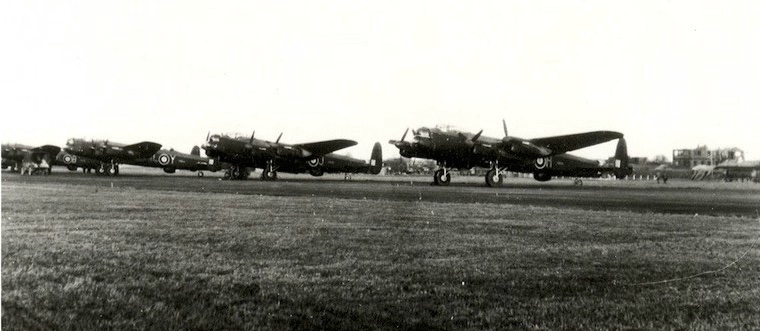
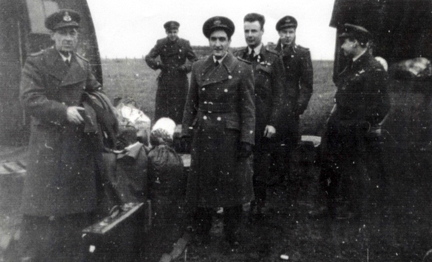 The Fern Crew L to R: P/O Jones, F/LT Rowe (Background), F/O Copeland, F/LT Fern, F/O Latremouille and F/O Marceau. (Absent - F/O Scott) |
Aircrews did not always fly sorties in the same Lancaster and on this March 11, 1945 mission to Essen KB834 was manned once again by an aircrew of seven courageous and dedicated RCAF/RAF airmen.
Christopher Lake, Saskatchewan, Canada F/LT George Rowe DFC -Navigator age 24 Toronto, Ontario, Canada F/O Joe Latremouille -Wireless Operator age 22 Toronto, Ontario, Canada F/O Ben Marceau -Rear Gunner age 24 Montreal, Quebec, Canada F/O Gibson Scott -Upper Gunner age 26 Vancouver, British Columbia, Canada F/O Thomas Copeland -Bomb Aimer age 25 Dundalk, Ontario, Canada P/O William Jones -Flight Engineer age 37 Liverpool, England |
The crew were all Canadian commissioned officers serving with the Royal Canadian Air Force except the Flight Engineer 37 year old P/O William Jones from Liverpool England who was serving with the Royal Air Force. He had served previously in 419 Squadron and was serving on his first tour. The rest of the crew were all serving on their second tours. This was a significant accomplishment for these airmen as RAF bomber losses in WW2 were staggeringly high with records indicating bomber command having suffered 51% casualty rates. 434 Squadron in fact was known as the unlucky squadron for having had far higher casualty rates than the other squadrons.
RAF 434 Squadron operational records indicate this was to be the Fern Crew's fifth operation and their third in a row in Lancaster KB834. The following is a list of missions by the Fern Crew RAF 434 Squadron. Rear Turret Gunner F/O Ben Marceau flew on 11 of these 12 missions.
|
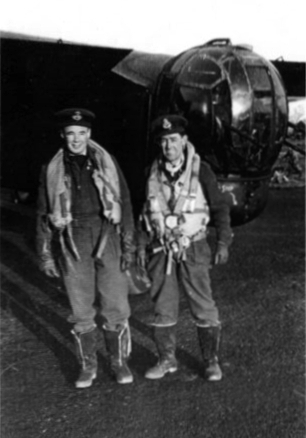 Pilot F/LT John Fern and Flight Engineer P/O William Jones. |
Their primary mission objective on the Essen bombing attack was to destroy the railway supply yards and railway lines in the industrial heart of Germany the city of Essen to try to prevent the transfers of munitions and materials to the German war front by enemy rail cars. RAF records state Essen was second only to the capital city of Berlin in terms of total allied bomb tonage dropped during the war.
|
Their mission began with departure at 1138 morning hours with the Fern Crew and Lancaster KB834 lining up in take off formations with dozens of the other bombers on the three RAF Croft runways. KB834 was powered by four Rolls-Royce Packard Merlin 1,620 hp inline engines which required the skilled piloting of F/LT John Fern who was highly regarded by his crew as being an experienced and excellent Lancaster pilot. After take off they positioned into flight formation within the bomber streams that totalled 1,079 RAF Aircraft that had also departed from numerous other RAF Bases throughout England. Each crewmember carefully checked over their bombers operations and equipment and their mission assignments. At this time period in WWII the Germans actually knew when there was going to be an allied bombing attack as they were able to pick up the wireless operators test transmissions before take off thus allowing the Germans to ready their defenses hours in advance of the approaching bomber streams, no doubt this was a major contributing factor in the high numbers of RAF bomber losses. Navigating on board RAF Lancaster KB834 was F/LT George Rowe DFC who was one of 4,018 RAF Airmen awarded the Distinguished Flying Cross Medal during WWII. F/LT Rowe was awarded his DFC when he previously served with RAF 432 Squadron 6 Group navigating on board RAF Wellington Aircraft flying missions out of RAF Skipton-on-Swale Then Moving To RAF East Moor Where 432 Squadron Switched To The Halifax Bomber. He also previously served on RAF Wellington's with RAF 425 Squadron 6 Group where he flew operations out of RAF Dishforth As An Observer & Navigator. All of these Royal Air Force Stations were located in North Yorkshire England. Now serving on his second tour of duty F/LT Navigator Rowe bravely flew on at least 42 RAF missions on RAF Wellington Halifax and Lancaster Aircraft during WWII. Navigator Rowe set their course on to Essen Germany taking KB834 along with the RAF bomber groups straight south over England then heading east over the straights of Dover and flying right across the English channel. This 1,079 plane RAF bomber stream was the second largest sent to a target in WWII it was massive in size and strength measuring approximately 8 miles long and five miles wide. After crossing the English Channel the bomber streams traveled over northern France and Belgium climbing steadily all the way heavily loaded with their bomb loads and then into German airspace reaching their scheduled bombing altitude heights of between 17,000 and 22,000 feet in an effort to avoid flak from the dangerous and accurate German anti-aircraft defenses. |
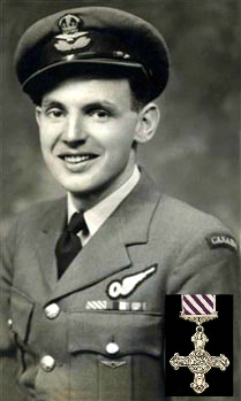 |
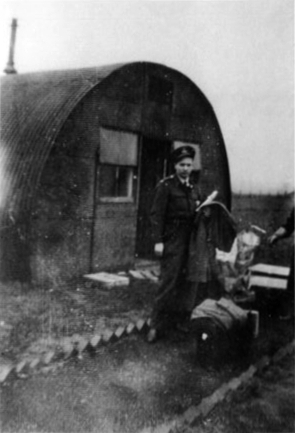 |
The RAF bomber streams and KB834 reached their objective target the Nazi war machine's railway supplies transfer yards over Essen at approximately 1522 afternoon hours over complete cloud cover. This was now a very dangerous and focused time in the mission for these well trained and experienced RAF Airmen as they were constantly on alert for not only German fighters like the ME-109 attacking the bomber formations and exploding flak but also from falling ordnance released from the bombers flying at higher altitudes. The Gibbins Crew in Lancaster NG201 of 153 Squadron piloted by F/O Eric Gibbins flying out of RAF Scrampton Air Force Base on their 26th operation is listed as lost on this mission due to a probable hit by a falling 4,000 lb bomb from another RAF bomber. Recent interviews with German fighter pilots has confirmed that Lancaster's were not as easy to detect in the skies over German airspace as the Halifax bomber. The reason was because the engines of the Lancaster's did not produce flames from the rear exhaust ports which could be seen from behind by patrolling Luftwaffe pilots from quite some distance away and especially at night. Right up to this point in their mission anti-aircraft fire was not that heavy and they had not been attacked by any enemy aircraft. Two reasons likely accounted for the lack of German fighters present on this attack, heavy cloud cover and also by March of 1945 the strength of the German's Luftwaffe and their airbases had been severely decimated. KB834 carried a standard 10 bombload ordnance consisting of the following, 1 blockbuster 4,000 lb bomb that resembled a long large barrel which crews called a cookie, 3 high explosive 1,000 lb bombs & 6 small bomb canisters. The SBC's carried either 236 x 4 lb or 24 x 30 lb fire starting incendiaries which were fuse timed to explode 600 meters over the strike zones. |
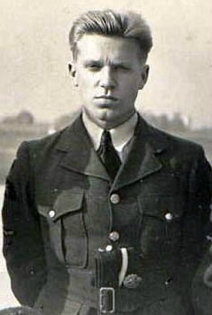 F/O Joe Latremouille. |
Flying at an altitude of 21,300 feet pilot John Fern and bomb aimer Tom Copeland began their bombing run guiding their Lancaster into the Essen target area over H2S directed sky markers. These were illuminated parachute flares in different mission coded colors that were dropped by H2S navigational radar equipped Pathfinder Lancaster's that flew in just ahead of the bomber streams to mark the strike zones. The use of H2S sky markers required a complicated offset bomber technique and was only done when heavy cloud cover was present over the target. Now flying over the exact target release point bomb aimer Copeland released KB834's bombload and approximately 33 seconds later they accurately struck the railway yard areas with devastating explosions. Copeland then requested to Fern over the aircrews intercom headset "Keep a straight course I want to take a good picture." Right after the crew heard Copeland's request their Lancaster suffered a catastrophic direct shell hit from what was very likely an 88 anti-aircraft shell and exploded in flames instantly killing all but one of the crewmembers. The Lancaster plunged on fire within seconds into the target area and crashed near Essen Margaretenhohe with wreckage spread over a two mile district. |
The shell explosion blew rear gunner Flying Officer Ben Marceau out of his armour plated stripped Frazer-Nash 20 rear turret. Falling from his Lancaster's bombing altitude height of 21,300 feet severely wounded and unconscious F/O Marceau regained consciousness falling at approximately 2,000 feet amidst heavy clouds. Miraculously he reached for and managed to grab and pull open his parachute cord landing seconds later heavily in a farmers field near Essen.
The shell that hit KB834 also blew out all of the cockpit windows of the trailing Lancaster that was following about 100 feet behind and 50 feet above as reported by it's crew upon returning safely to base at RAF Croft.
Two Russian men who were very likely working in the fields as POW forced labourers seen the airman parachute to the ground and rushed over to his aid. F/O Marceau was badly injured in the legs shoulders eye and face and they helped the wounded Canadian by using his first aid kit to dress his wounds. He then gave them his two survival kits that he was carrying as he wanted the men to keep them knowing that his capture was soon at hand as he could see that three German soldiers were running towards them from a distance away. When the soldiers arrived they immediately searched him three times over for weapons and documents. Present was a sergeant who was searching for a pistol but he could not find a gun as he was not armed. The sergeant then took both survival kits away from the Russian men and the other two German soldiers who were about 15 years old picked F/O Marceau up and walked him about 1 kilometer back to their flak post, all the way the older sergeant was kicking him from behind in the legs. However he was not further injured by this mistreatment as he was protected by his heavy flying boots.
After arriving back at the Germans flak post he was released which somewhat surprised him. Feeling exhausted and in severe pain he sat himself down against a fence and found it quite odd that the German soldiers were staying away from him as if frightened. Perhaps they in part were sensing that the day of reckoning was near for Germany. A wooden stretcher was later brought to about 10 feet of where he was sitting and feeling really faint he got up and laid himself down on top of it. He was then picked up and placed in the back of a German troop transport truck onto the floor in between 2 rows of German soldiers. One of the soldiers began trying to remove his wedding band. Now at the point of falling into unconsciousness the last thing he could recall was clinching his left hand so his ring could not be taken from him.
Later that day he awoke only very briefly on the operating table in the hospital rooms of the German flak barracks where he would then remain unconscious until the 16th of March. After regaining back into consciousness he was then interrogated by a German flak post officer who asked him "The names of your crew and where are your other four crewmembers?", apparently not knowing that Lancaster's did carry seven airmen. My research of records indicates that this same German flak post officer after the war did provide information on this aircrew and KB834's crash site to the Royal Air Force. On March 20th the area of this hospital was bombed and he was walked across the street to yet another hospital but the roof of that one was soon on fire as well and he had to be moved again.
During this time as an injured POW F/O Marceau thankfully credits Dr. Otto Trush the commanding officer of one of the hospitals he was being treated in with possibly saving his life as a very determined SS officer named Captain Schmidt identified him as an allied airman and attempted several times to try to have him released into the custody of the German Vermarcht. This hospital officer was able to prevent this from happening by arguing against it by stating that the Canadian airman was not fit to be transferred by the SS.
The Nazi's SS were guilty of having committed countless war crimes during the war and if they had been successful in taking F/O Marceau into their custody he could very well have died from either neglect or he could have been executed by the Nazi Gestapo like so many other downed allied airmen in fact were. F/O Ben Marceau was very fortunate to have survived through this time as an injured prisoner of war spending the next seven weeks in hospitals in Germany and also in Belgium before being liberated in the Ruhr by American Forces just five days before Victory In Europe Day May 8th 1945 and the end of the second world war. |
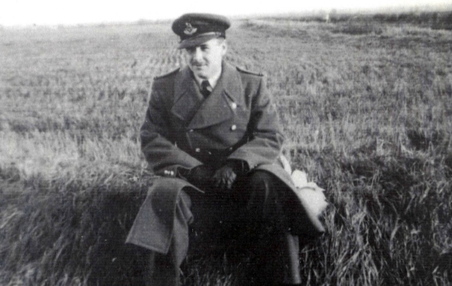 Rear Turret Gunner F/O Ben Marceau. |
After the war F/O Marceau remained in hospitals for treatments of his injuries for a lengthy period of time. He flew 11 missions with the Fern Crew and 47 missions in total in WWII during two tours of North Africa and Europe. At this time June 2005 Ben Marceau lives peacefully today in Montreal Quebec Canada serving as the treasurer of 425 Squadron Association.
The days and weeks following March the 11th when the Fern Crew did not return home from this mission to Essen were an extremely emotional period of time for the families as they were unsure whether any of the crewmembers had survived the explosion and crash of Lancaster KB834. It is my hope that they discover and learn more about their story here. Individual memorials to the Fern Crew can now be viewed online at Veterans Affairs Canada The Canadian Virtual War Memorial
[ https://www.veterans.gc.ca/eng/remembrance/memorials/canadian-virtual-war-memorial/ ]
